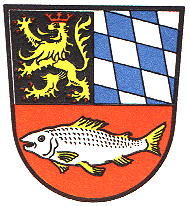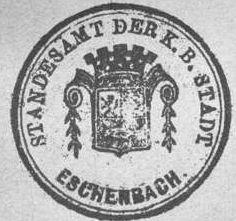Eschenbach in der Oberpfalz: Difference between revisions
Knorrepoes (talk | contribs) m (Text replacement - "{{media}}" to " {{de1}} {{media1}}") |
Knorrepoes (talk | contribs) m (Text replacement - "{{de}}" to "") |
||
| Line 1: | Line 1: | ||
'''ESCHENBACH IN DER OBERPFALZ''' | '''ESCHENBACH IN DER OBERPFALZ''' | ||
Revision as of 16:50, 26 December 2022
ESCHENBACH IN DER OBERPFALZ
State : Bayern
District (Kreis) : Neustadt an der Waldnaab (until 1973 Eschenbach in der Oberpfalz)
Additions : 1946 Stegenthumbach; 1972 Pichlberg (partly)
| German |
Geteilt und oben gespalten; vorne in Schwarz ein rot gekrönter goldener Löwe, hinten von Silber und Blau geweckt, unten in Rot ein silberner Fisch. |
| English | in der Oberpfalz No blazon/translation known. Please click here to send your (heraldic !) blazon or translation |
Origin/meaning
The oldest seal of the city dates from 1382 and shows in the upper half a lion and in the lower a fish. The lion is the lion of Bohemia, as the city at the time was a possession of the Kings of Bohemia. The fish is likely a symbol for the latter part of the name; Bach means stream.
When the city became a possession of the Dukes of Bayern, the lion was replaced by the lion of the Pfalz and the diamonds of the Wittelsbach family (Dukes of Bayern and Princes of the Pfalz). The combination has been used since the middle of the 16th century on the seals and the arms thus have not changed since.
| The arms on a municipal stamp (1892) |
The arms by Hupp in the Kaffee Hag albums +/- 1925 |
| Municipal stationery, 1960s |
Literature: Stadler, 1964-1971, 8 volumes.



